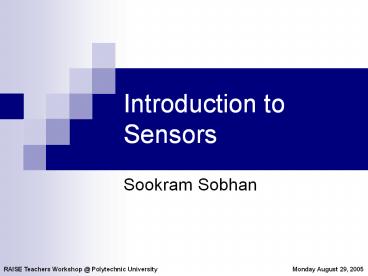Introduction to Sensors PowerPoint PPT Presentation
1 / 17
Title: Introduction to Sensors
1
Introduction to Sensors
- Sookram Sobhan
2
Overview
- What are Sensors?
- Detectable Phenomenon
- Physical Principles How Do Sensors Work?
- Need for Sensors
- Choosing a Sensor
- Sensor Descriptions
- Temperature Sensor
- Accelerometer
- Light Sensor
- Magnetic Field Sensor
- Ultrasonic Sensor
- Photogate
- CO2 Gas Sensor
3
What are Sensors?
- American National Standards Institute (ANSI)
Definition - A device which provides a usable output in
response to a specified measurand - A sensor acquires a physical parameter and
converts it into a signal suitable for processing
(e.g. optical, electrical, mechanical) - A transducer
- Microphone, Loud Speaker, Biological Senses (e.g.
touch, sight,ect)
4
Detectable Phenomenon
5
Physical Principles
- Amperess Law
- A current carrying conductor in a magnetic field
experiences a force (e.g. galvanometer) - Curie-Weiss Law
- There is a transition temperature at which
ferromagnetic materials exhibit paramagnetic
behavior - Faradays Law of Induction
- A coil resist a change in magnetic field by
generating an opposing voltage/current (e.g.
transformer) - Photoconductive Effect
- When light strikes certain semiconductor
materials, the resistance of the material
decreases (e.g. photoresistor)
6
Need for Sensors
- Sensors are omnipresent. They embedded in our
bodies, automobiles, airplanes, cellular
telephones, radios, chemical plants, industrial
plants and countless other applications. - Without the use of sensors, there would be no
automation !! - Imagine having to manually fill Poland Spring
bottles
7
Choosing a Sensor
8
Temperature Sensor
- Temperature sensors appear in building, chemical
process plants, engines, appliances, computers,
and many other devices that require temperature
monitoring - Many physical phenomena depend on temperature, so
we can often measure temperature indirectly by
measuring pressure, volume, electrical
resistance, and strain
9
Temperature Sensor
- Bimetallic Strip
- Application
- Thermostat (makes or breaks electrical connection
with deflection)
10
Temperature Sensor
- Resistance temperature device.
11
Accelerometer
- Accelerometers are used to measure along one axis
and is insensitive to orthogonal directions - Applications
- Vibrations, blasts, impacts, shock waves
- Air bags, washing machines, heart monitors, car
alarms - Mathematical Description is beyond the scope of
this presentation. See me during lunch if
interested
12
Light Sensor
- Light sensors are used in cameras, infrared
detectors, and ambient lighting applications - Sensor is composed of photoconductor such as a
photoresistor, photodiode, or phototransistor
13
Magnetic Field Sensor
- Magnetic Field sensors are used for power
steering, security, and current measurements on
transmission lines - Hall voltage is proportional to magnetic field
14
Ultrasonic Sensor
- Ultrasonic sensors are used for position
measurements - Sound waves emitted are in the range of 2-13 MHz
- Sound Navigation And Ranging (SONAR)
- Radio Dection And Ranging (RADAR)
ELECTROMAGNETIC WAVES !!
15
Photogate
- Photogates are used in counting applications
(e.g. finding period of period motion) - Infrared transmitter and receiver at opposite
ends of the sensor - Time at which light is broken is recorded
16
CO2 Gas Sensor
- CO2 sensor measures gaseous CO2 levels in an
environment - Measures CO2 levels in the range of 0-5000 ppm
- Monitors how much infrared radiation is absorbed
by CO2 molecules
17
Thank You

